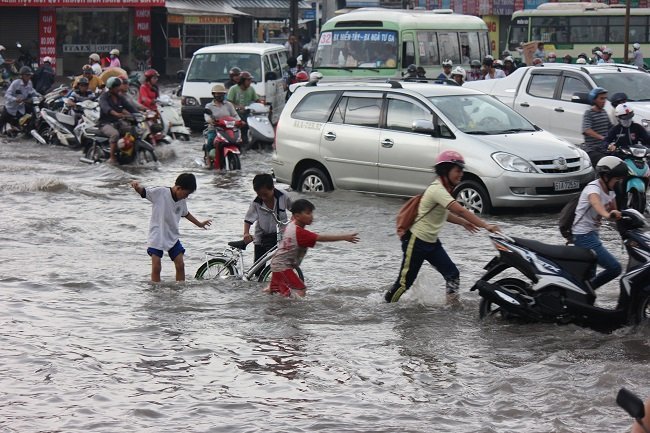The HCMC government has spent trillions of Vietnamese dong on flood control, but its efforts have yet to pay off. More effective solutions are needed to cope with the situation, experts said at a meeting in HCMC on June 20.

Residents in HCMC wade through floodwater in this file photo
Organized by the Environmental Technology Center under the Vietnam Association for the Conservation of Nature and the Environment, the meeting was aimed at finding ways to cope with floods caused by heavy rains and high tides, Sai Gon Giai Phong newspaper reported.
The city has spent more than VND22 trillion (US$963 million) dealing with the situation for over 10 years. The figure will likely amount to a staggering VND120 trillion (US$5.25 billion) by 2020.
Vu Hai, former deputy president and general secretary of the HCMC Water and Environment Association, noted that the city’s flooding situation worsens, as more flood-prone sites emerge every year.
Antiflood projects that are under construction are not properly examined, resulting in exorbitant costs and lengthy execution, according to Hai.
He stressed that the flooding situation has affected the quality of life of local residents and created economic losses for them.
A study on the impact of tidal flooding on residents of District 7, conducted by the Vietnam National University in HCMC, suggested that households suffered an average loss of VND13 million (US$569) each, while household businesses lost VND13.4 million, and companies and other organizations lost VND24 million (US$1,050).
Local households had to spend money on repairing their damaged floors, walls, electrical equipment and other assets, as well as on improving their drainage systems inside and outside their houses. They also had to take the time to move their belongings.
In addition to these direct losses, companies and other organizations suffered other indirect costs, such as being forced to stop production for four days, on average, followed by another four days of slow production, as well as having to deal with equipment damage and other costs arising from the flooding situation.
Households, household businesses, companies and other organizations were also subject to intangible damage, such as traffic congestion and vacation time, paying out salaries ranging from VND10 billion to VND90 billion per year, depending on flooding levels, ranging from 10 centimeters to one meter.
Le Anh Tuan from the HCMC Steering Center of the Urban Flood Control Program noted that the municipal government has been introducing various projects to tackle the thorny problem.
The city is speeding up the rehabilitation of the 32-kilometer Tham Luong-Ben Cat-Nuoc Len basin and the 8.2-kilometer Xuyen Tam Canal to facilitate drainage and reduce the flooding risk for many parts of the city.
Further, the city is building eight flood tide sluices, 68 minor under-dyke sluices and seven or eight embankments along Saigon River, and it is dredging and renovating major drainage shafts along the canals of Thu Dao, Ong Be, Thay Tieu, Xom Cui and Lung Mam.
Once these projects are put into operation by 2020, the flooding situation will be resolved for the city’s central basin and for some of the five 550-square-kilometer peripheral basins that are home to 6.5 million people, claimed Tuan.
However, according to environmental experts, the mere focus on work construction solutions is not enough. Vu Hai of the HCMC Water and Environment Association said the city should also pay attention to flood control due to high tides and rains, and wastewater treatment.
For instance, the city should try to raise the capacity of water storage in households and increase the number of flood plains, thereby reducing pressure on drainage systems.
The city should also raise the amount of water used to replenish groundwater sources to prevent infrastructure subsidence because of groundwater overexploitation and to reduce deep flooding in areas where the infrastructure has sunk.
In addition, the city should make full use of ecological lakes to regulate the amount of water released in case of heavy rain.
Experts stressed there will not be enough money in the State budget to solve the city’s flooding situation completely.
SGT